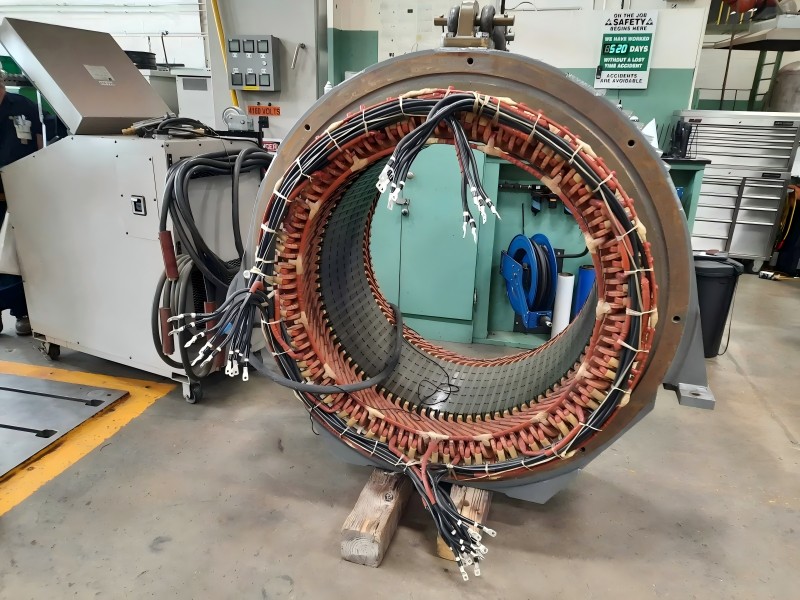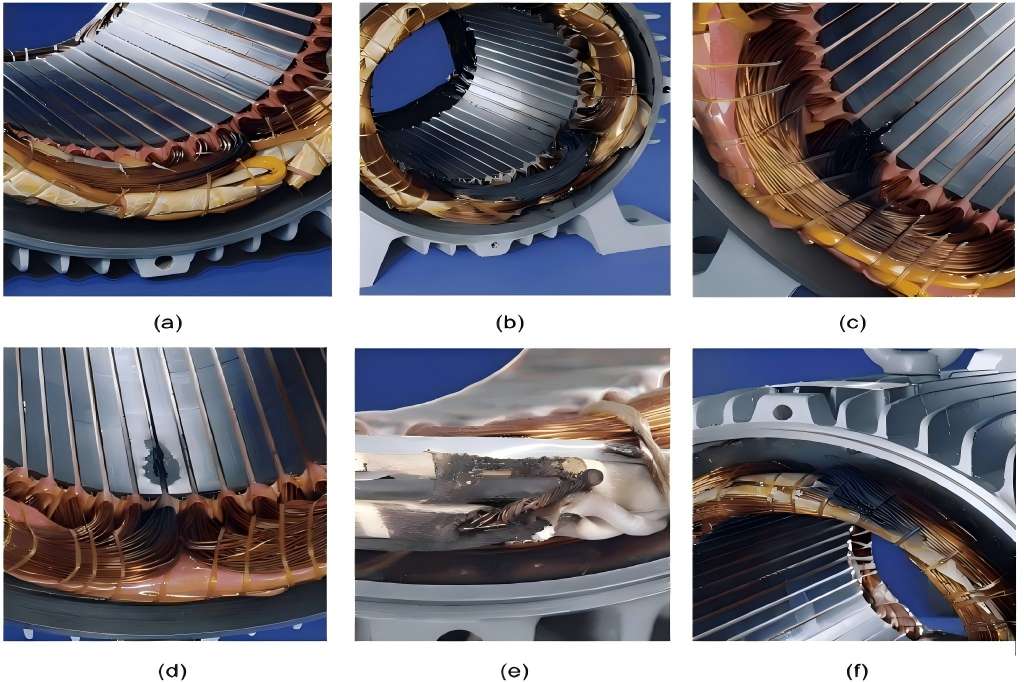Motors and generators depend on stator and rotor cores to transform electrical energy into mechanical energy. They are key to motor performance, efficiency, and durability. However, like any mechanical part, stators and rotors can face problems that affect motor function.
This article covers the 10 common issues with stator and rotor cores, their causes, and possible solutions.
1. Core Loss (Iron Loss)

Core loss, sometimes referred to as iron loss, is the dissipation of energy in the form of heat that happens when a stator or rotor core experiences changes in magnetic flux. This loss reduces the motor’s efficiency, causing energy wastage and overheating.
Cause: Hysteresis and eddy currents in the core’s material are the main causes of core loss. These losses become more pronounced when the core material is of poor quality, improperly laminated, or if the laminations are not sufficiently insulated.
Solution: Using premium materials, like silicon steel, which has a reduced hysteresis loss, is the way to reduce core loss. Additionally, the lamination thickness should be optimized, as thinner laminations reduce eddy currents. Proper insulation between the laminations can also help reduce losses.
2. Insulation Failure
One of the most dangerous problems with stator and rotor cores is insulation breakdown. The insulation protects the windings from electrical shorts, and failure can lead to motor breakdowns, short circuits, or complete motor failure.
Cause: Insulation failure can occur due to aging, exposure to excessive temperatures, mechanical stress, or contaminants. Insulation deterioration can be accelerated by subpar production techniques or the use of subpar insulation materials.
Solution: Early indicators of insulation degradation can be found with the aid of routine maintenance and inspections. Using high-quality, temperature-resistant insulation materials and employing better manufacturing techniques can significantly reduce the risk of failure. In addition, ensuring that the motor operates within its rated temperature limits is essential.
3. Overheating
Overheating of the stator and rotor cores can cause various issues, including reduced motor efficiency, accelerated wear, and permanent damage to the windings.
Cause: Overheating can be caused by excessive current, poor ventilation, inadequate cooling systems, or core material inefficiencies. Environmental conditions like high ambient temperatures or insufficient cooling mechanisms in the motor can exacerbate the problem.
Solution: Ensuring adequate ventilation around the motor is crucial to preventing overheating. Additionally, improving the cooling system, such as adding external fans or enhancing the motor’s heat dissipation, can help manage the temperature. Using high-efficiency materials for the cores and maintaining the motor’s load within specified limits is crucial.
4. Mechanical Vibrations
Mechanical vibrations in stator and rotor cores are another common issue that can negatively impact the performance of motors and generators. The bearings, core, and other parts may prematurely fail as a result of these vibrations.
Cause: Vibrations are often caused by imbalanced rotor assemblies, poor alignment, or faults in the manufacturing process that result in uneven lamination placement. External forces, such as unbalanced loads or external shock, can also contribute to vibrations.
Solution: Ensuring proper balancing during the manufacturing process is critical to minimizing mechanical vibrations. Additionally, regular alignment checks and the use of high-precision manufacturing methods can help mitigate vibration issues. In some cases, vibration-damping materials can be added to further reduce the impact.
5. Core Saturation
When the magnetic flux density in the stator or rotor core is more than what the material can withstand, core saturation happens. This results in a reduction in the motor’s overall performance and efficiency.
Cause: Core saturation can be caused by overloading, improper design, or incorrect selection of the core material. Using a material that cannot withstand the motor’s operational conditions can lead to early saturation.
Solution: Using cores made from high-quality materials with higher magnetic permeability, such as high-grade silicon steel, can reduce the risk of saturation. Ensuring that the motor is designed correctly with appropriate core dimensions and operating conditions can also prevent this issue. Regular monitoring of the motor’s load conditions is essential to avoid overloading.
6. Cracked or Damaged Laminations
Cracked or damaged laminations can occur in both stator and rotor cores, often resulting in mechanical failure, poor performance, or even complete motor shutdown.
Cause: Cracks typically occur during the manufacturing process, especially if the lamination material is not adequately handled or if the stamping dies are not correctly calibrated. Excessive heat or mechanical stress during operation can also cause cracks in the laminations.
Solution: To avoid cracking, it’s crucial to use high-quality, durable laminations made from tough material, such as high-grade electrical steel. Proper care during handling and the use of quality control checks during the stamping process can prevent damage. Additionally, minimizing excessive thermal and mechanical stress during motor operation will also help prevent cracks.
7. Winding Shorts
Winding shorts refer to electrical faults where the winding turns short-circuit each other, leading to overheating, loss of motor torque, and, in severe cases, complete motor failure.
Cause: These shorts are typically caused by insulation failure, contamination, or mechanical wear. High temperatures, improper winding procedures, or aging of the motor can contribute to this issue.
Solution: The use of superior insulation materials is essential to prevent winding shorts. Additionally, employing advanced manufacturing techniques, such as precision winding, can reduce the risk. Regular inspection of winding conditions and maintaining proper cooling mechanisms are also important in preventing winding shorts.
8. Magnetic Pull Issues
Magnetic pull issues arise when the magnetic fields in the stator and rotor cores are not balanced, resulting in uneven forces that can cause vibrations, heating, and inefficient motor operation.
Cause: Magnetic pull problems are often caused by poor rotor alignment, uneven air gaps, or defects in the stator’s lamination structure. These inconsistencies create uneven magnetic forces that disrupt the motor’s smooth operation.
Solution: Ensuring precise rotor and stator alignment is critical for balanced magnetic fields. Using high-quality, defect-free laminations and maintaining proper air gap distances between the stator and rotor are essential to resolving magnetic pull issues. Regular quality checks and calibration during manufacturing can also prevent these problems from occurring.
9. Noise and Audible Hum
Excessive noise and audible hum from a motor can be a sign of underlying issues with the stator and rotor cores. Although some noise is typical, unusual noises may be a sign that the motor isn’t working properly.
Cause: Noise and hum often result from mechanical vibrations, magnetic forces, or issues with the lamination quality. Poorly laminated cores or improper design can cause friction, leading to noise production.
Solution: Proper lamination of the stator and rotor cores can help minimize friction and reduce noise levels. Additionally, maintaining proper motor alignment and balance, along with reducing mechanical vibrations, can prevent excessive noise. In some cases, soundproofing materials or dampening solutions can be used to further reduce audible hum.
10. Poor Core Bonding
Core bonding issues occur when the individual laminations of a stator or rotor core fail to adhere properly, leading to poor mechanical integrity, reduced efficiency, and potential motor failure.
Cause: Poor core bonding can occur during the manufacturing process if the adhesive used is of low quality or if the lamination layers are not aligned correctly. Additionally, environmental factors such as humidity or extreme temperatures can affect the bonding integrity.
Solution: High-quality bonding agents and precise alignment techniques are crucial for ensuring proper core bonding. Lamination stacking can be made more consistent and human error can be decreased by using automated procedures. Regular inspection and quality control measures can ensure that core bonding remains intact during the motor’s lifespan.
Conclusion
Stator and rotor core issues are common in motors and generators. Finding their causes and applying solutions can improve performance, extend lifespan, and reduce failure risks. Quality materials, precise manufacturing, and regular maintenance ensure reliable operation. Advances in technology and materials will address these issues, leading to more efficient and durable motors for industrial use.



